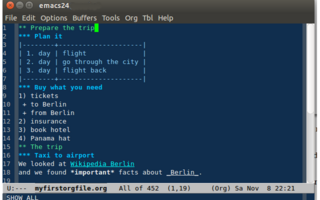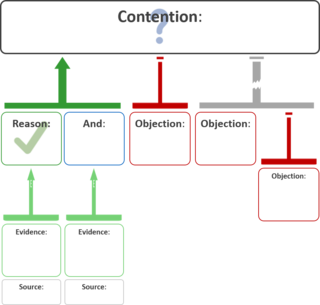
A mind map is a diagram used to visually organize information into a hierarchy, showing relationships among pieces of the whole. It is often based on a single concept, drawn as an image in the center of a blank page, to which associated representations of ideas such as images, words and parts of words are added. Major ideas are connected directly to the central concept, and other ideas branch out from those major ideas.

Memex [memory expansion] is a hypothetical electromechanical device for interacting with microform documents and described in Vannevar Bush's 1945 article "As We May Think". Bush envisioned the memex as a device in which individuals would compress and store all of their books, records, and communications, "mechanized so that it may be consulted with exceeding speed and flexibility". The individual was supposed to use the memex as an automatic personal filing system, making the memex "an enlarged intimate supplement to his memory".
In computing, a search engine is an information retrieval software system designed to help find information stored on one or more computer systems. Search engines discover, crawl, transform, and store information for retrieval and presentation in response to user queries. The search results are usually presented in a list and are commonly called hits. The most widely used type of search engine is a web search engine, which searches for information on the World Wide Web.
Collaborative software or groupware is application software designed to help people working on a common task to attain their goals. One of the earliest definitions of groupware is "intentional group processes plus software to support them."
A personal information manager is a type of application software that functions as a personal organizer. The acronym PIM is now, more commonly, used in reference to personal information management as a field of study. As an information management tool, a PIM tool's purpose is to facilitate the recording, tracking, and management of certain types of "personal information".
Social software, also known as social apps or social platform includes communications and interactive tools that are often based on the Internet. Communication tools typically handle capturing, storing and presenting communication, usually written but increasingly including audio and video as well. Interactive tools handle mediated interactions between a pair or group of users. They focus on establishing and maintaining a connection among users, facilitating the mechanics of conversation and talk. Social software generally refers to software that makes collaborative behaviour, the organisation and moulding of communities, self-expression, social interaction and feedback possible for individuals. Another element of the existing definition of social software is that it allows for the structured mediation of opinion between people, in a centralized or self-regulating manner. The most improved area for social software is that Web 2.0 applications can all promote co-operation between people and the creation of online communities more than ever before. The opportunities offered by social software are instant connections and opportunities to learn. An additional defining feature of social software is that apart from interaction and collaboration, it aggregates the collective behaviour of its users, allowing not only crowds to learn from an individual but individuals to learn from the crowds as well. Hence, the interactions enabled by social software can be one-to-one, one-to-many, or many-to-many.

An outliner is a specialized type of text editor used to create and edit outlines, which are text files which have a tree structure or a tree view, for organization. Textual information is contained in discrete sections called "nodes", which are arranged according to their topic–subtopic (parent–child) relationships, like the members of a family tree. When loaded into an outliner, an outline may be collapsed or expanded to display as few or as many levels as desired.

Coined in 1987, the term Knowledge Navigator described a future computing system and how people might use it to navigate worlds of knowledge. In a sense, the user is actually the “Knowledge Navigator,” though the term often refers to the system’s primary interface, a tablet computer. That part often stands for the whole system. The term is also the title of an Apple “vision video.” The concept was described by former Apple Computer CEO John Sculley and John A. Byrne in their book, Odyssey: Pepsi to Apple.
“A future-generation Macintosh, which we should have early in the twenty-first century, might well be a wonderful fantasy machine called the Knowledge Navigator, a discoverer of worlds, a tool as galvanizing as the printing press. Individuals could use it to drive through libraries, museums, databases, or institutional archives. This tool wouldn't just take you to the doorstep of these great resources as sophisticated computers do now; it would invite you deep inside its secrets, interpreting and explaining—converting vast quantities of information into personalized and understandable knowledge.”

A decision support system (DSS) is an information system that supports business or organizational decision-making activities. DSSs serve the management, operations and planning levels of an organization and help people make decisions about problems that may be rapidly changing and not easily specified in advance—i.e., unstructured and semi-structured decision problems. Decision support systems can be either fully computerized or human-powered, or a combination of both.
In computer science, interactive computing refers to software which accepts input from the user as it runs.
A semantic wiki is a wiki that has an underlying model of the knowledge described in its pages. Regular, or syntactic, wikis have structured text and untyped hyperlinks. Semantic wikis, on the other hand, provide the ability to capture or identify information about the data within pages, and the relationships between pages, in ways that can be queried or exported like a database through semantic queries.
A personal wiki is wiki software that allows individual users to organize information on their desktop or mobile computing devices in a manner similar to community wikis, but without collaborative software or multiple users.

An argument map or argument diagram is a visual representation of the structure of an argument. An argument map typically includes all the key components of the argument, traditionally called the conclusion and the premises, also called contention and reasons. Argument maps can also show co-premises, objections, counterarguments, rebuttals, and lemmas. There are different styles of argument map but they are often functionally equivalent and represent an argument's individual claims and the relationships between them.
Ontotext is a software company that produces software relating to data management. Its main products are GraphDB, an RDF database; and Ontotext Platform, a general data management platform based on knowledge graphs. It was founded in 2000 in Bulgaria, and now has offices internationally. Together with the BBC, Ontotext developed one of the early large-scale industrial semantic applications, Dynamic Semantic Publishing, starting in 2010.
In computer science, the semantic desktop is a collective term for ideas related to changing a computer's user interface and data handling capabilities so that data are more easily shared between different applications or tasks and so that data that once could not be automatically processed by a computer could be. It also encompasses some ideas about being able to share information automatically between different people. This concept is very much related to the Semantic Web, but is distinct insofar as its main concern is the personal use of information.

The issue-based information system (IBIS) is an argumentation-based approach to clarifying wicked problems—complex, ill-defined problems that involve multiple stakeholders. Diagrammatic visualization using IBIS notation is often called issue mapping.

"As We May Think" is a 1945 essay by Vannevar Bush which has been described as visionary and influential, anticipating many aspects of information society. It was first published in The Atlantic in July 1945 and republished in an abridged version in September 1945—before and after the atomic bombings of Hiroshima and Nagasaki. Bush expresses his concern for the direction of scientific efforts toward destruction, rather than understanding, and explicates a desire for a sort of collective memory machine with his concept of the memex that would make knowledge more accessible, believing that it would help fix these problems. Through this machine, Bush hoped to transform an information explosion into a knowledge explosion.
Productivity software is application software used for producing information. Its names arose from it increasing productivity, especially of individual office workers, from typists to knowledge workers, although its scope is now wider than that. Office suites, which brought word processing, spreadsheet, and relational database programs to the desktop in the 1980s, are the core example of productivity software. They revolutionized the office with the magnitude of the productivity increase they brought as compared with the pre-1980s office environments of typewriters, paper filing, and handwritten lists and ledgers. In the United States, some 78% of "middle-skill" occupations now require the use of productivity software. In the 2010s, productivity software had become even more consumerized than it already was, as computing became ever more integrated into daily personal life.

A Zettelkasten or card file consists of small items of information stored on Zettels, paper slips or cards, that may be linked to each other through subject headings or other metadata such as numbers and tags. It has often been used as a system of note-taking and personal knowledge management for research, study, and writing.

Obsidian is a personal knowledge base and note-taking software application that operates on Markdown files. It allows users to make internal links for notes and then to visualize the connections as a graph. It is designed to help users organize and structure their thoughts and knowledge in a flexible, non-linear way. The software is free for personal use, with commercial licenses available for pay.










